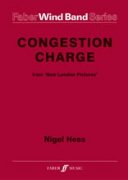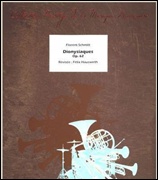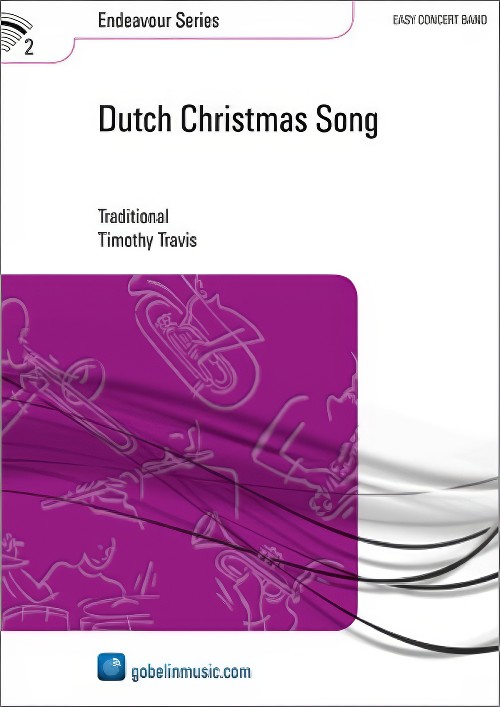Results
-
 £75.00
£75.00Commencement (Concert Band - Score and Parts) - Wilson, Curtis
This excellent overture was written for the TCU Wind Ensemble. Heroic in character, the piece masterfully exploits the variety of colors available to the modern wind ensemble through interesting solis and solos. This piece is tonal in nature and contains many original and identifiable themes.
Estimated dispatch 7-14 working days
-
 £173.25
£173.25Concertino for Marimba and Winds
Written for famed Japanese marimba soloist, Reiko Kono. This concerto-like work is accompanied by the full resources of the modern concert band. The movements are a romantic "Nocturne", a gay, lilting "Scherzetto", and a brilliant "Toccata" which is surprisingly set to a swing-boogie rhythmic background.
Estimated dispatch 7-14 working days
-
 £55.00
£55.00Congestion Charge (from New London Pictures) (Concert Band - Score and Parts) - Hess, Nigel
As with all modern cities, London is over-crowded with motor vehicles. London is the first major city in Europe to adopt a 'Congestion Charge', and this piece (with its stop and go traffic lights) is both racy and comical. Here are Londoners attempting to go about their business in the face of overwhelming odds..... This piece is the final movement Nigel Hess' 'New London Pictures' which represents elements of London in the 21st Century.Duration: 7.00
Estimated dispatch 7-14 working days
-
 £79.20
£79.20Dance and Intermezzo (Concert Band - Score and Parts)
Great uptempo march that requires limited rehearsal time. A wonderful march for your younger bands, but also sound great with the pros! "March for Modern" has been a top seller in the Barnhouse catalog for many years.
Estimated dispatch 7-14 working days
-
 £76.99
£76.99Dancing Zoo (Concert Band - Score and Parts)
This suite with a four-part instrumentation is comprised of three cheerful, imaginative movements: firstly Yellow Duck Shuffle, a bluesy, swinging section; next comes Purple Panda Polka, a lively, modern polka in which a funny dancing pair of pandas take centre stage; and finally the third movement entitled Pink Donkey Boogie is a gentle boogie-woogie. The musical motifs are played in all four parts giving every instrumentalist a chance to take the lead. 0:06:30
Estimated dispatch 7-14 working days
-
 £199.95
£199.95DIONYSIAQUES (Advanced Concert Band) - Schmitt, Florent - Hauswirth, Felix
Edited by Felix Hauswirth, this masterwork for wind band has long been a staple of the repertoire, considered the pre-eminent composition of original French wind band music. Re-scored by Felix for modern wind instrumentation, the score and parts have been visually cleaned up and corrected for ease of use and study.
Estimated dispatch 7-14 working days
-
 £60.99
£60.99Dutch Christmas Song (Concert Band - Score and Parts) - Travis, Timothy
Dutch Christmas Song is an arrangement of the old Dutch song Hoe leit dit Kindeke (Vlaanderen, 1897). The tender, almost fragile words have been movingly honoured by Timothy Travis. The addition of percussion gives this lovely Christmas song a modern touch.Duration: 2:30
Estimated dispatch 7-14 working days
-
 £202.99
£202.99El Quijote Wind Band Set (Score & Parts)
El Quijote is based on Cervantes novel Don Quixote. This gem of Spanish literature has captured the whole world, and is widely acclaimed to be not only one of the most influential and emblematic work in the field of Spanish literature, but more generally a founding work of modern Western literature. Ferrer Ferran composed the symphonic fantasy El Quijote on the occasion of the 400th anniversary of this literary work. The composition can be performed with an optional narrator who declaims from Cervantes? work. 16:06
Estimated dispatch 7-14 working days
-
 £64.35
£64.35Emblem of Freedom
Karl King was widely quoted as saying that "Emblem of Freedom" is the best march he ever wrote and you certainly won't get any argument on that from us. Andrew Glover's new edition is not simplified or abridged in any way but does provide for a modern concert band instrumentation and includes helpful articulations and dynamic markings to make your performances a total success! Perfect for any concert or contest performance. OUTSTANDING IN EVERY RESPECT!
Estimated dispatch 7-14 working days
-
 £89.99
£89.99Enjoy the Music (Concert Band - Score and Parts)
Enjoy the Music' is the motto of Austrian composer Thomas Doss. This motto is reflected in this lively concert work in which the composer shows music is melody, harmony, rhythm, dynamics, timbre and much more. The modern yet tuneful melodies of this piece make use of all the colours of the concert band and the results speak for themselves. This item will be a definite favourite with both performers and audience. 04:30
Estimated dispatch 7-14 working days
